Triple-Band Terahertz Chiral Metasurface for Spin-Selective Absorption and Reflection Phase Manipulation
Abstract
1. Introduction
2. Models and Theories
3. Results and Discussion
4. Conclusions
Author Contributions
Funding
Conflicts of Interest
References
- Shen, S.; Liu, X.; Shen, Y.; Qu, J.; Pickwell-MacPherson, E.; Wei, X.; Sun, Y. Recent Advances in the Development of Materials for Terahertz Metamaterial Sensing. Adv. Opt. Mater. 2022, 10, 2101008. [Google Scholar] [CrossRef]
- Kleiner, R. Filling the Terahertz Gap. Science 2007, 318, 1254–1255. [Google Scholar] [CrossRef] [PubMed]
- Yu, N.; Capasso, F. Flat Optics with Designer Metasurfaces. Nat. Mater. 2014, 13, 139–150. [Google Scholar] [CrossRef] [PubMed]
- Dong, L.; Si, L.; Xu, H.; Shen, Q.; Lv, X.; Zhuang, Y.; Zhang, Q. Rapid Customized Design of a Conformal Optical Transparent Metamaterial Absorber Based on the Circuit Analog Optimization Method. Opt. Express 2022, 30, 8303–8316. [Google Scholar] [CrossRef]
- Fan, K.; Suen, J.Y.; Liu, X.; Padilla, W.J. All-Dielectric Metasurface Absorbers for Uncooled Terahertz Imaging. Optica 2017, 4, 601–604. [Google Scholar] [CrossRef]
- Chen, X.; Huang, L.; Mühlenbernd, H.; Li, G.; Bai, B.; Tan, Q.; Jin, G.; Qiu, C.-W.; Zhang, S.; Zentgraf, T. Dual-Polarity Plasmonic Metalens for Visible Light. Nat. Commun. 2012, 3, 1198. [Google Scholar] [CrossRef]
- Zhao, F.; Li, Z.; Dai, X.; Liao, X.; Li, S.; Cao, J.; Shang, Z.; Zhang, Z.; Liang, G.; Chen, G.; et al. Broadband Achromatic Sub-Diffraction Focusing by an Amplitude-Modulated Terahertz Metalens. Adv. Opt. Mater. 2020, 8, 2000842. [Google Scholar] [CrossRef]
- Fang, S.; Luan, K.; Ma, H.F.; Lv, W.; Li, Y.; Zhu, Z.; Guan, C.; Shi, J.; Cui, T.J. Asymmetric Transmission of Linearly Polarized Waves in Terahertz Chiral Metamaterials. J. Appl. Phys. 2017, 121, 033103. [Google Scholar] [CrossRef]
- Stolarek, M.; Yavorskiy, D.; Kotyński, R.; Rodríguez, C.J.Z.; Łusakowski, J.; Szoplik, T. Asymmetric Transmission of Terahertz Radiation through a Double Grating. Opt. Lett. 2013, 38, 839–841. [Google Scholar] [CrossRef]
- Zhang, H.; Yang, C.; Liu, M.; Zhang, Y. Dual-Function Tuneable Asymmetric Transmission and Polarization Converter in Terahertz Region. Results Phys. 2021, 25, 104242. [Google Scholar] [CrossRef]
- Cheng, G.; Si, L.; Tang, P.; Zhang, Q.; Lv, X. Study of Symmetries of Chiral Metasurfaces for Azimuth-Rotation-Independent Cross Polarization Conversion. Opt. Express 2022, 30, 5722–5730. [Google Scholar] [CrossRef] [PubMed]
- Cheng, G.; Si, L.; Tang, P.; Zhuang, Y.; Sun, H.; Ding, J. Topology Optimization of the Azimuth-Rotation-Independent Polarization Conversion Metasurface for Bandwidth Enhancement. Opt. Express 2022, 30, 41340–41349. [Google Scholar] [CrossRef] [PubMed]
- Yang, Q.; Wang, Y.; Liang, L.; Yang, M. Broadband Transparent Terahertz Vortex Beam Generator Based on Thermally Tunable Geometric Metasurface. Opt. Mater. 2021, 121, 111574. [Google Scholar] [CrossRef]
- Yue, Z.; Liu, J.; Li, J.; Li, J.; Zheng, C.; Wang, G.; Chen, M.; Xu, H.; Wang, Q.; Xing, X.; et al. Multifunctional Terahertz Metasurfaces for Polarization Transformation and Wavefront Manipulation. Nanoscale 2021, 13, 14490–14496. [Google Scholar] [CrossRef] [PubMed]
- Liang, Y.; Lin, H.; Koshelev, K.; Zhang, F.; Yang, Y.; Wu, J.; Kivshar, Y.; Jia, B. Full-Stokes Polarization Perfect Absorption with Diatomic Metasurfaces. Nano Lett. 2021, 21, 1090–1095. [Google Scholar] [CrossRef]
- Liang, Y.; Koshelev, K.; Zhang, F.; Lin, H.; Lin, S.; Wu, J.; Jia, B.; Kivshar, Y. Bound States in the Continuum in Anisotropic Plasmonic Metasurfaces. Nano Lett. 2020, 20, 6351–6356. [Google Scholar] [CrossRef]
- Ahmadivand, A.; Gerislioglu, B.; Ahuja, R.; Kumar Mishra, Y. Terahertz Plasmonics: The Rise of Toroidal Metadevices towards Immunobiosensings. Mater. Today 2020, 32, 108–130. [Google Scholar] [CrossRef]
- Eidelshtein, G.; Fardian-Melamed, N.; Gutkin, V.; Basmanov, D.; Klinov, D.; Rotem, D.; Levi-Kalisman, Y.; Porath, D.; Kotlyar, A. Synthesis and Properties of Novel Silver-Containing DNA Molecules. Adv. Mater. 2016, 28, 4839–4844. [Google Scholar] [CrossRef]
- Plum, E.; Zheludev, N.I. Chiral Mirrors. Appl. Phys. Lett. 2015, 106, 221901. [Google Scholar] [CrossRef]
- Wang, Q.; Plum, E.; Yang, Q.; Zhang, X.; Xu, Q.; Xu, Y.; Han, J.; Zhang, W. Reflective Chiral Meta-Holography: Multiplexing Holograms for Circularly Polarized Waves. Light Sci. Appl. 2018, 7, 25. [Google Scholar] [CrossRef]
- Basiri, A.; Chen, X.; Bai, J.; Amrollahi, P.; Carpenter, J.; Holman, Z.; Wang, C.; Yao, Y. Nature-Inspired Chiral Metasurfaces for Circular Polarization Detection and Full-Stokes Polarimetric Measurements. Light Sci. Appl. 2019, 8, 78. [Google Scholar] [CrossRef] [PubMed]
- Hajji, M.; Cariello, M.; Gilroy, C.; Kartau, M.; Syme, C.D.; Karimullah, A.; Gadegaard, N.; Malfait, A.; Woisel, P.; Cooke, G.; et al. Chiral Quantum Metamaterial for Hypersensitive Biomolecule Detection. ACS Nano 2021, 15, 19905–19916. [Google Scholar] [CrossRef] [PubMed]
- Wang, Z.; Jia, H.; Yao, K.; Cai, W.; Chen, H.; Liu, Y. Circular Dichroism Metamirrors with Near-Perfect Extinction. ACS Photonics 2016, 3, 2096–2101. [Google Scholar] [CrossRef]
- Jing, L.; Wang, Z.; Yang, Y.; Zheng, B.; Liu, Y.; Chen, H. Chiral Metamirrors for Broadband Spin-Selective Absorption. Appl. Phys. Lett. 2017, 110, 231103. [Google Scholar] [CrossRef]
- Stojanovic, D.B.; Gligoric, G.; Belicev, P.P.; Belic, M.R.; Hadzievski, L. Circular Polarization Selective Metamaterial Absorber in Terahertz Frequency Range. IEEE J. Sel. Top. Quantum Electron. 2021, 27, 1–6. [Google Scholar] [CrossRef]
- Ouyang, L.; Rosenmann, D.; Czaplewski, D.A.; Gao, J.; Yang, X. Broadband Infrared Circular Dichroism in Chiral Metasurface Absorbers. Nanotechnology 2020, 31, 295203. [Google Scholar] [CrossRef]
- Liu, M.; Plum, E.; Li, H.; Duan, S.; Li, S.; Xu, Q.; Zhang, X.; Zhang, C.; Zou, C.; Jin, B.; et al. Switchable Chiral Mirrors. Adv. Opt. Mater. 2020, 8, 2000247. [Google Scholar] [CrossRef]
- Zhang, Y.; Liu, H.; Xu, R.; Qin, Z.; Teng, C.; Deng, S.; Chen, M.; Cheng, Y.; Deng, H.; Yang, H.; et al. Tunable Circular Dichroism Based on Graphene-Metal Split Ring Resonators. Opt. Express 2021, 29, 21020–21030. [Google Scholar] [CrossRef]
- Li, H.; Li, J.; Zheng, C.; Xu, H.; Yang, F.; Li, J.; Li, J.; Yue, Z.; Shi, W.; Shi, W.; et al. Dual-Band Giant Spin-Selective Full-Dimensional Manipulation of Graphene-Based Chiral Meta-Mirrors for Terahertz Waves. Opt. Express 2022, 30, 22292–22305. [Google Scholar] [CrossRef]
- Cui, Y.; Wang, X.; Jiang, H.; Jiang, Y. High-Efficiency and Tunable Circular Dichroism in Chiral Graphene Metasurface. J. Phys. Appl. Phys. 2022, 55, 135102. [Google Scholar] [CrossRef]
- Wang, H.; Jing, Y.; Li, Y.; Huang, L.; Feng, M.; Yuan, Q.; Wang, J.; Zhang, J.; Qu, S. Spin-Selective Corner Reflector for Retro-Reflection and Absorption by a Circular Dichroitic Manner. Photonics Res. 2021, 9, 726. [Google Scholar] [CrossRef]
- Jing, L.; Wang, Z.; Maturi, R.; Zheng, B.; Wang, H.; Yang, Y.; Shen, L.; Hao, R.; Yin, W.; Li, E.; et al. Gradient Chiral Metamirrors for Spin-Selective Anomalous Reflection. Laser Photonics Rev. 2017, 11, 1700115. [Google Scholar] [CrossRef]
- Lin, M.; Liu, C.; Yi, J.; Jiang, Z.H.; Chen, X.; Xu, H.-X.; Burokur, S.N. Chirality-Intrigged Spin-Selective Metasurface and Applications in Generating Orbital Angular Momentum. IEEE Trans. Antennas Propag. 2022, 70, 4549–4557. [Google Scholar] [CrossRef]
- Huang, Y.; Xiao, T.; Xie, Z.; Zheng, J.; Su, Y.; Chen, W.; Liu, K.; Tang, M.; Müller-Buschbaum, P.; Li, L. Single-Layered Reflective Metasurface Achieving Simultaneous Spin-Selective Perfect Absorption and Efficient Wavefront Manipulation. Adv. Opt. Mater. 2021, 9, 2001663. [Google Scholar] [CrossRef]
- Wang, L.; Huang, X.; Li, M.; Dong, J. Chirality Selective Metamaterial Absorber with Dual Bands. Opt. Express 2019, 27, 25983–25993. [Google Scholar] [CrossRef]
- Tang, H.; Rosenmann, D.; Czaplewski, D.A.; Yang, X.; Yang, X.; Gao, J.; Gao, J.; Gao, J. Dual-Band Selective Circular Dichroism in Mid-Infrared Chiral Metasurfaces. Opt. Express 2022, 30, 20063–20075. [Google Scholar] [CrossRef]
- Gou, Y.; Ma, H.F.; Wang, Z.X.; Wu, L.W.; Wu, R.Y.; Cui, T.J. Dual-Band Chiral Metasurface for Independent Controls of Spin-Selective Reflections. Opt. Express 2022, 30, 12775–12787. [Google Scholar] [CrossRef]
- Gao, W.; Huang, C.; Feng, Z.; Li, M.; Dong, J. Circular Dichroism Metamirror with Diversified Chiral Molecules Combinations. Opt. Express 2021, 29, 33367–33379. [Google Scholar] [CrossRef]
- Zhang, L.; Liu, S.; Li, L.; Cui, T.J. Spin-Controlled Multiple Pencil Beams and Vortex Beams with Different Polarizations Generated by Pancharatnam-Berry Coding Metasurfaces. ACS Appl. Mater. Interfaces 2017, 9, 36447–36455. [Google Scholar] [CrossRef]
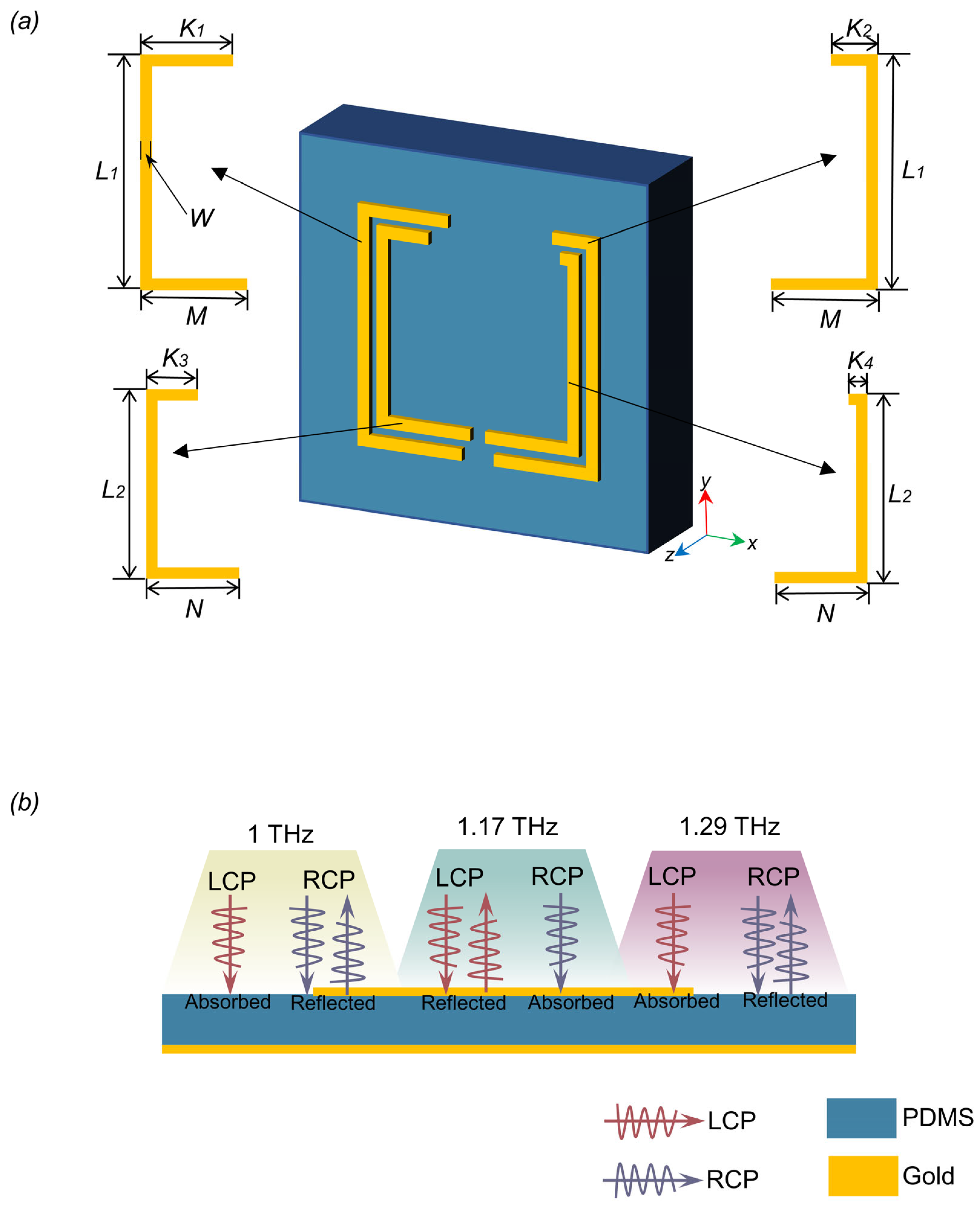

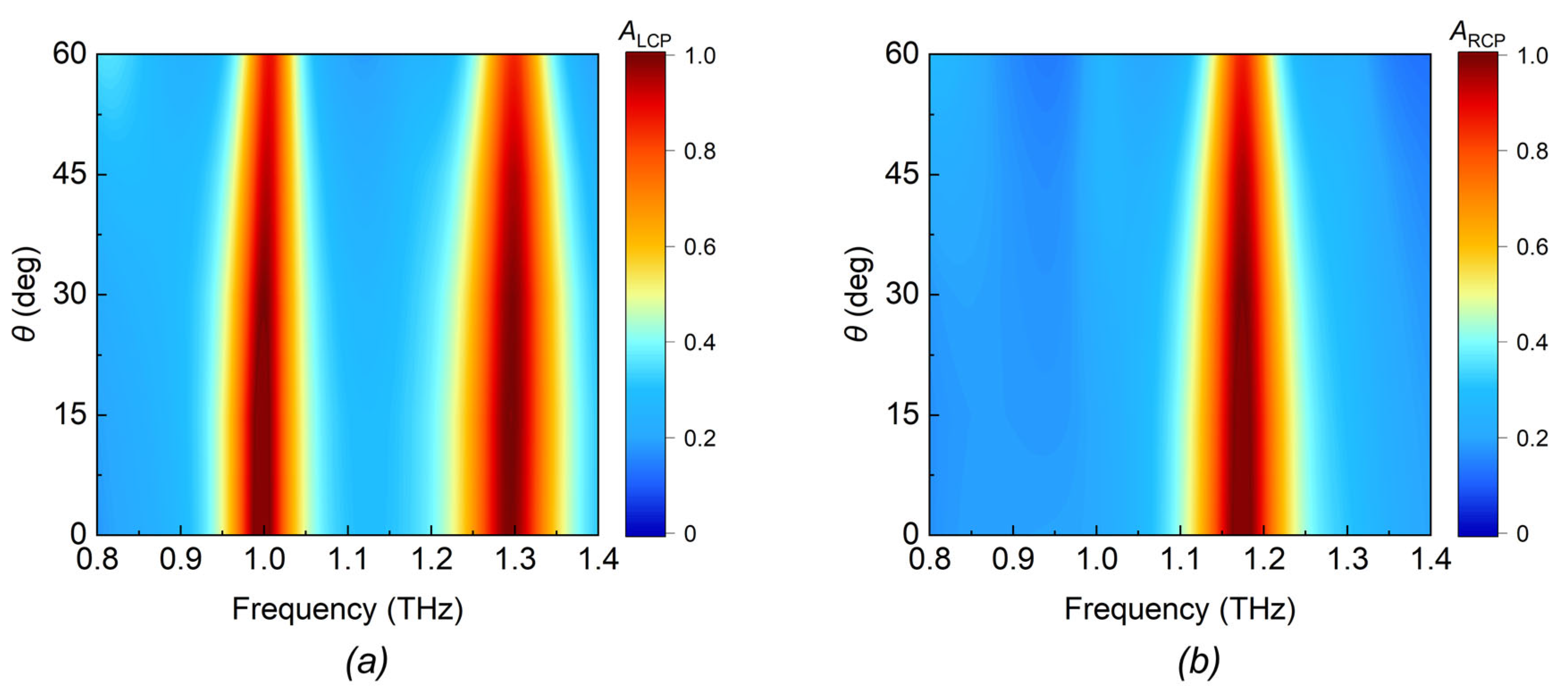
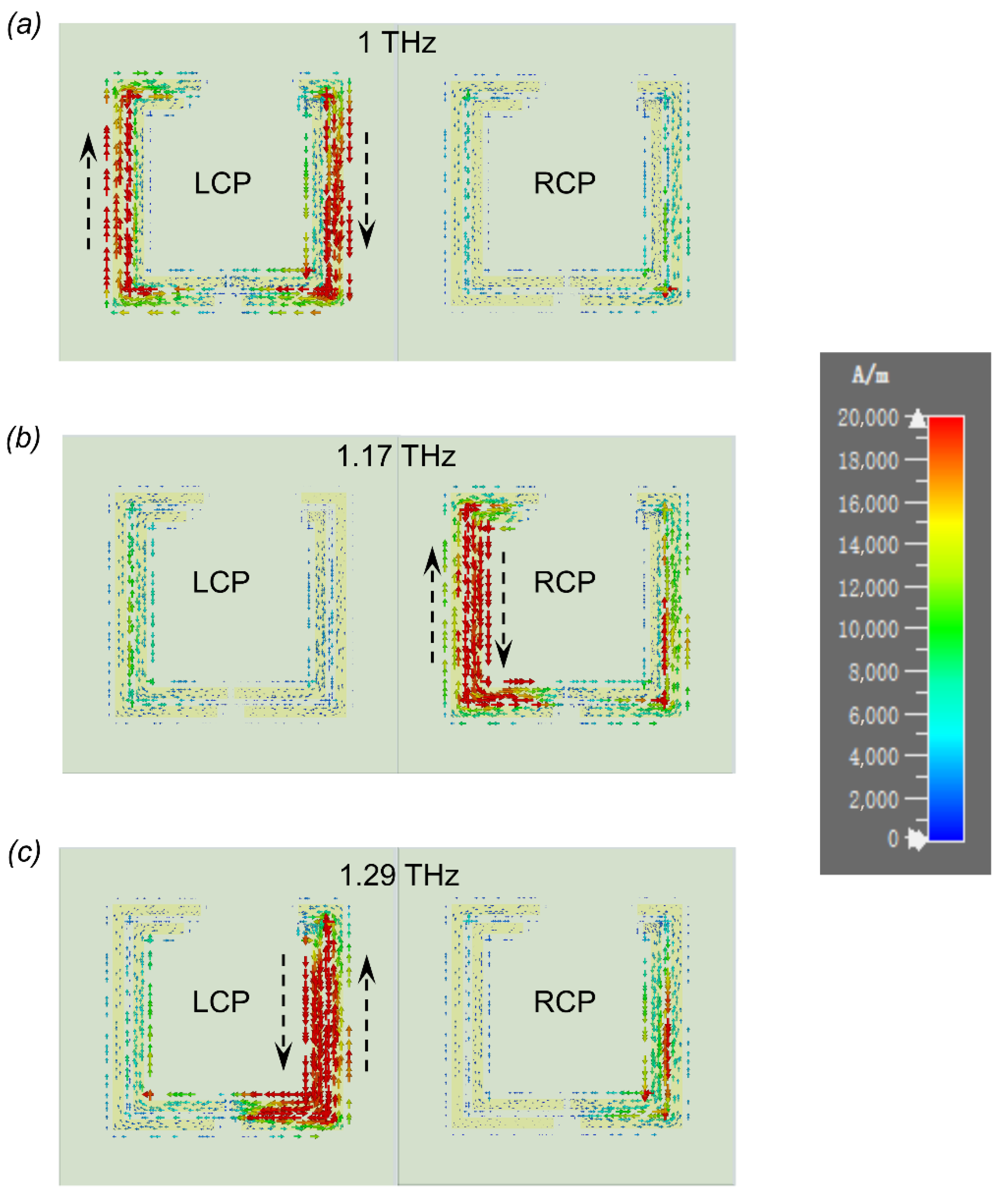
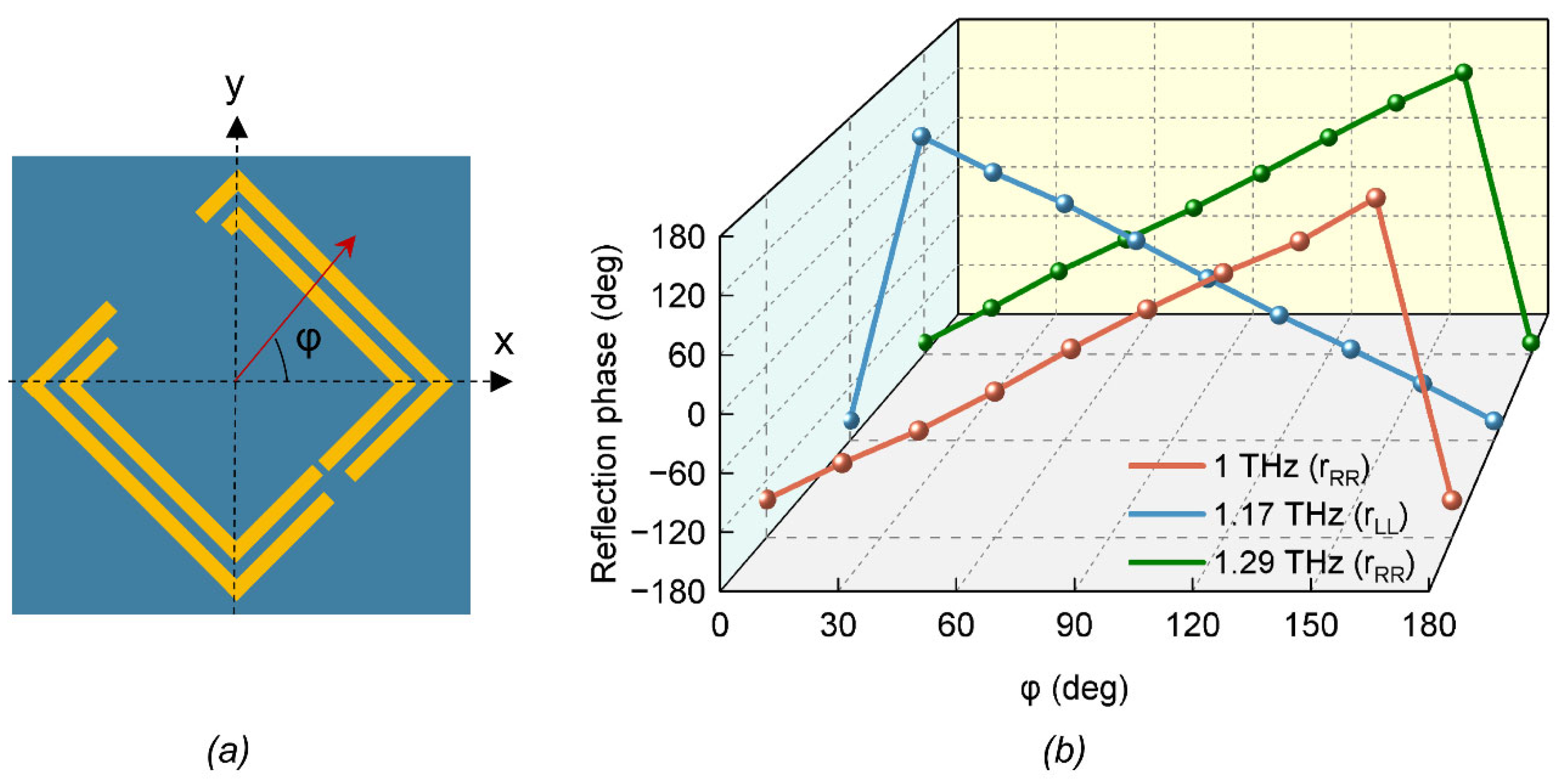
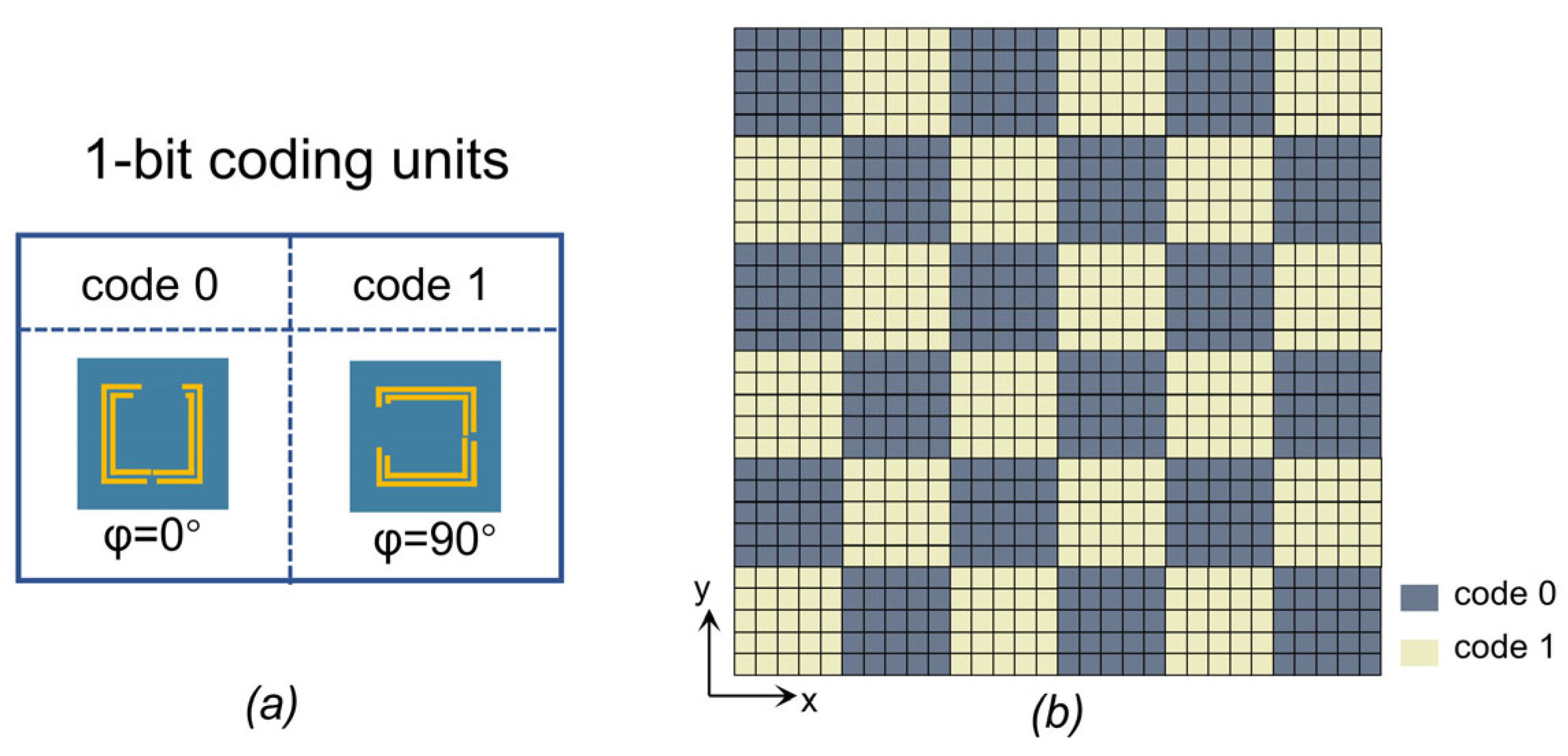
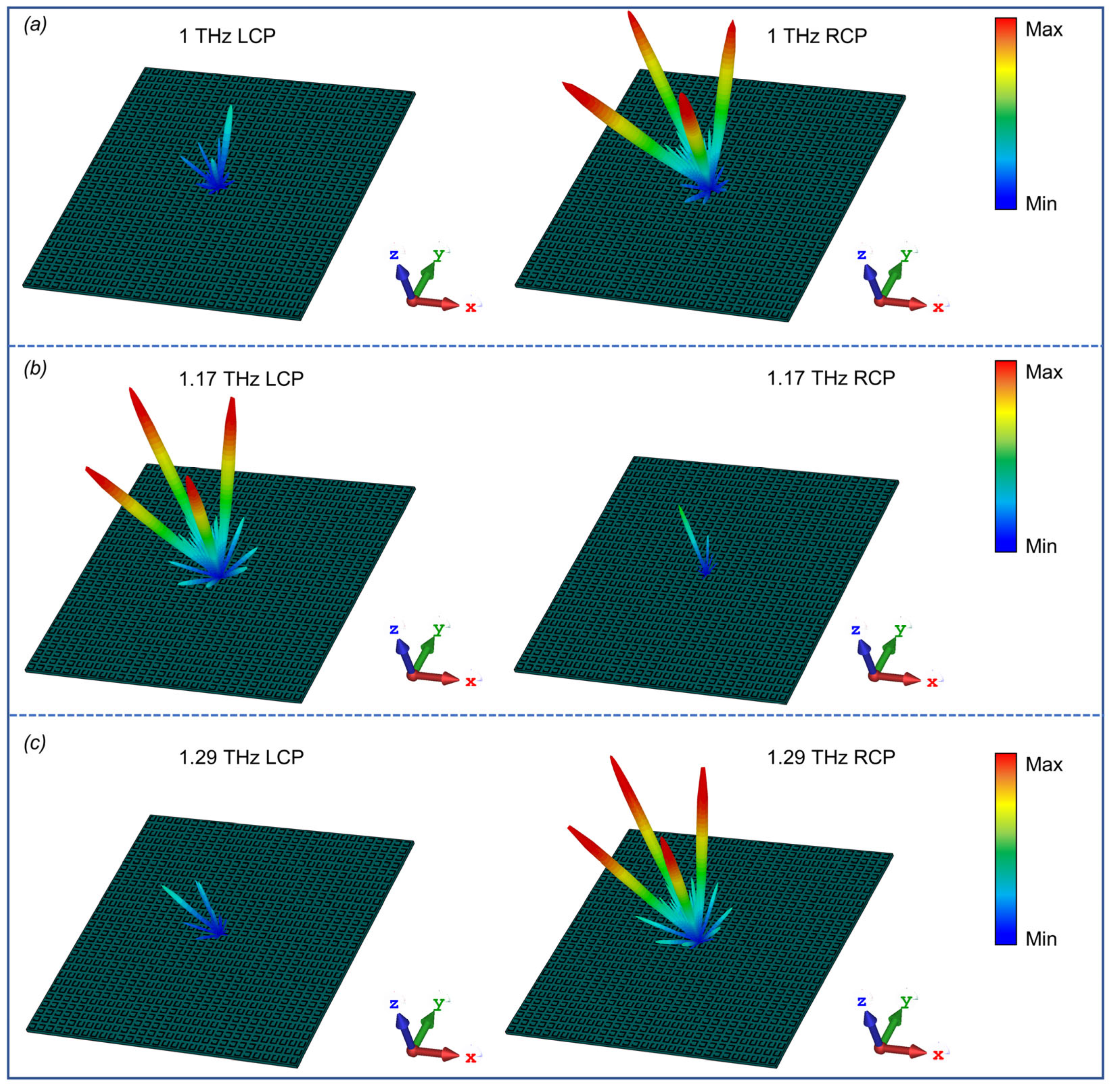
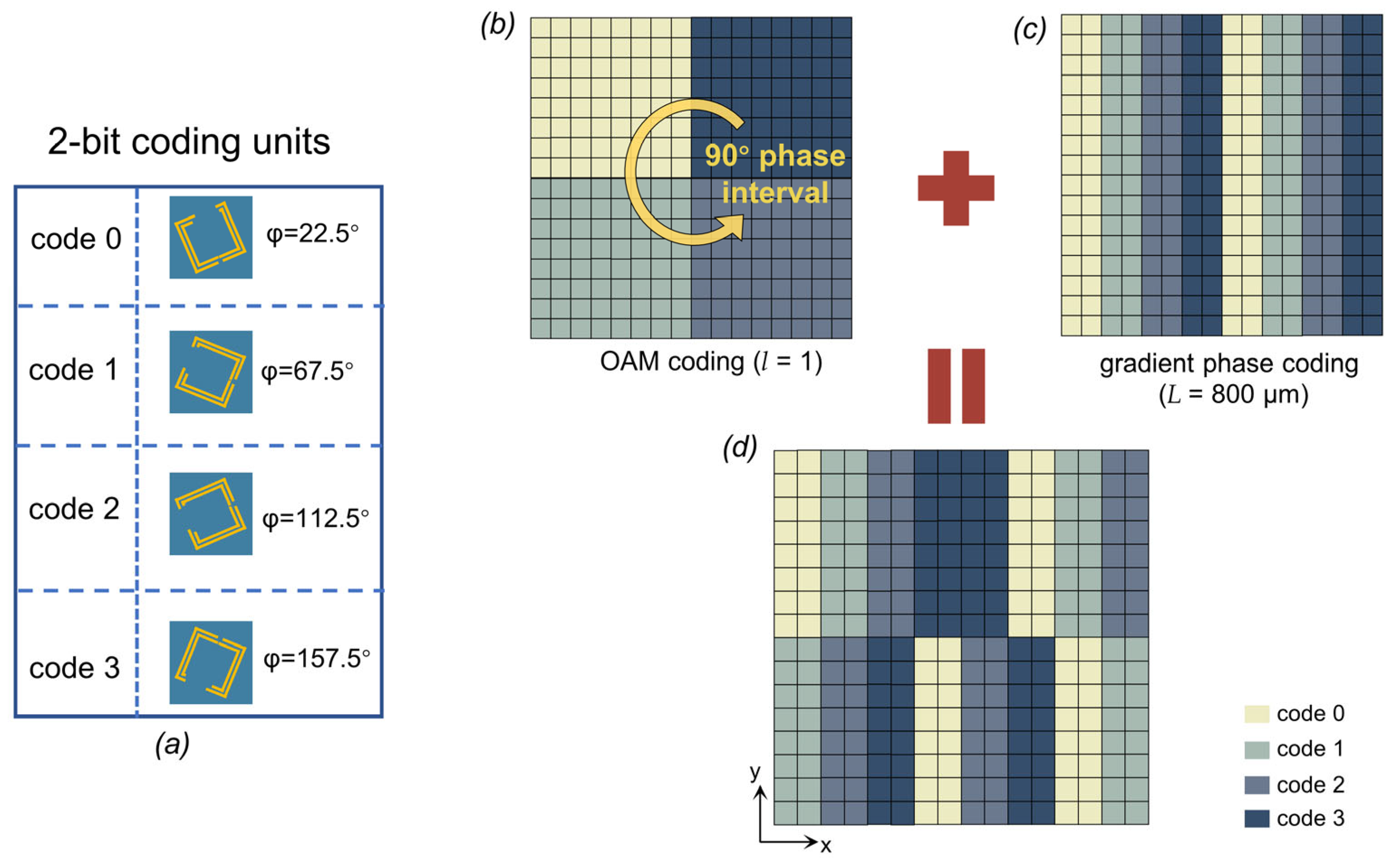
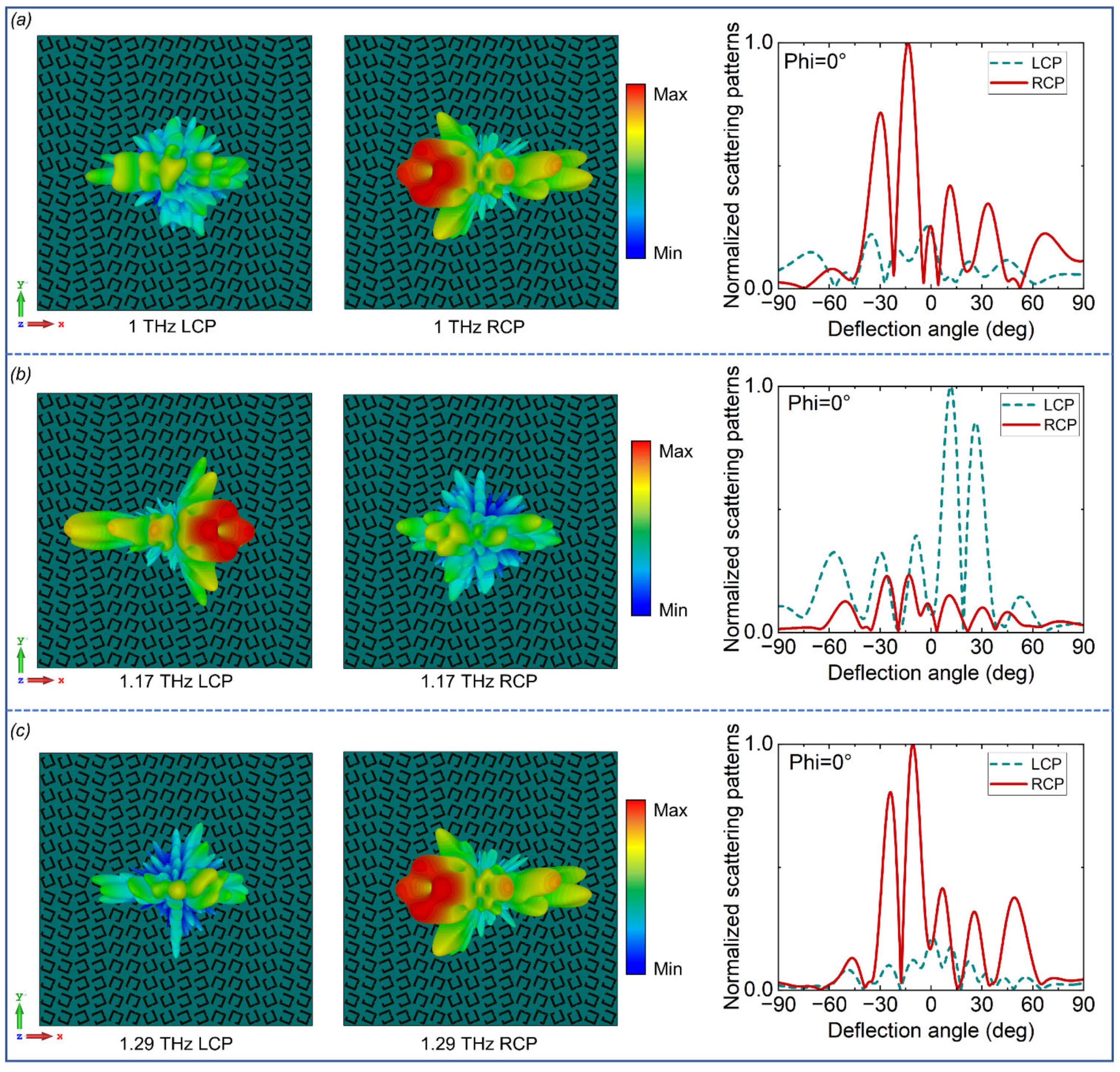
| Parameter Name | L1 | L2 | K1 | K2 | K3 | K4 | M | N | W |
| Value | 66 | 55 | 26 | 13.2 | 15 | 5.5 | 30 | 27 | 3.3 |
| Ref. | Spectrum | Band Coverage | CD Peaks | Phase Manipulation |
|---|---|---|---|---|
| [30] | Terahertz | Single band | 0.87 | Not mentioned |
| [33] | Microwave | Single band | 0.85 | Yes |
| [35] | Microwave | Dual bands | 0.78 (1st band) 0.69 (2nd band) | Not mentioned |
| [38] | Microwave | Dual bands | 0.72 (1st band) −0.79 (2nd band) | Not mentioned |
| [36] | Mid-infrared | Dual bands | <0.6 | Not mentioned |
| [29] | Terahertz | Dual bands | 0.64 (1st band) 0.75 (2nd band) | Yes |
| This work | Terahertz | Triple bands | 0.80 (1st band) −0.66 (2nd band) 0.64 (3rd band) | Yes |
Publisher’s Note: MDPI stays neutral with regard to jurisdictional claims in published maps and institutional affiliations. |
© 2022 by the authors. Licensee MDPI, Basel, Switzerland. This article is an open access article distributed under the terms and conditions of the Creative Commons Attribution (CC BY) license (https://creativecommons.org/licenses/by/4.0/).
Share and Cite
Zhang, H.; Si, L.; Ma, T.; Dong, L.; Niu, R.; Bao, X.; Sun, H.; Ding, J. Triple-Band Terahertz Chiral Metasurface for Spin-Selective Absorption and Reflection Phase Manipulation. Electronics 2022, 11, 4195. https://doi.org/10.3390/electronics11244195
Zhang H, Si L, Ma T, Dong L, Niu R, Bao X, Sun H, Ding J. Triple-Band Terahertz Chiral Metasurface for Spin-Selective Absorption and Reflection Phase Manipulation. Electronics. 2022; 11(24):4195. https://doi.org/10.3390/electronics11244195
Chicago/Turabian StyleZhang, Hang, Liming Si, Tianyu Ma, Lin Dong, Rong Niu, Xiue Bao, Houjun Sun, and Jun Ding. 2022. "Triple-Band Terahertz Chiral Metasurface for Spin-Selective Absorption and Reflection Phase Manipulation" Electronics 11, no. 24: 4195. https://doi.org/10.3390/electronics11244195
APA StyleZhang, H., Si, L., Ma, T., Dong, L., Niu, R., Bao, X., Sun, H., & Ding, J. (2022). Triple-Band Terahertz Chiral Metasurface for Spin-Selective Absorption and Reflection Phase Manipulation. Electronics, 11(24), 4195. https://doi.org/10.3390/electronics11244195








